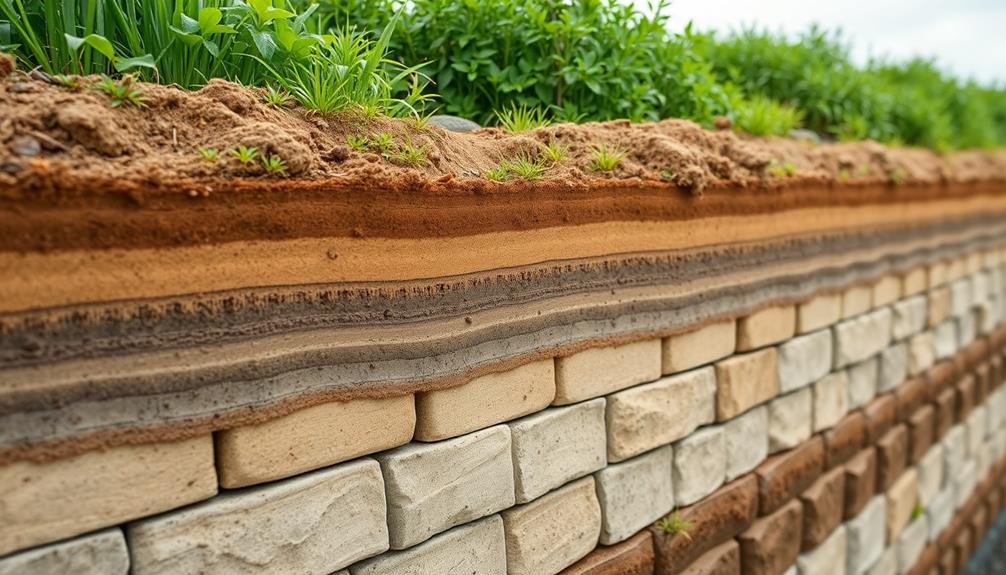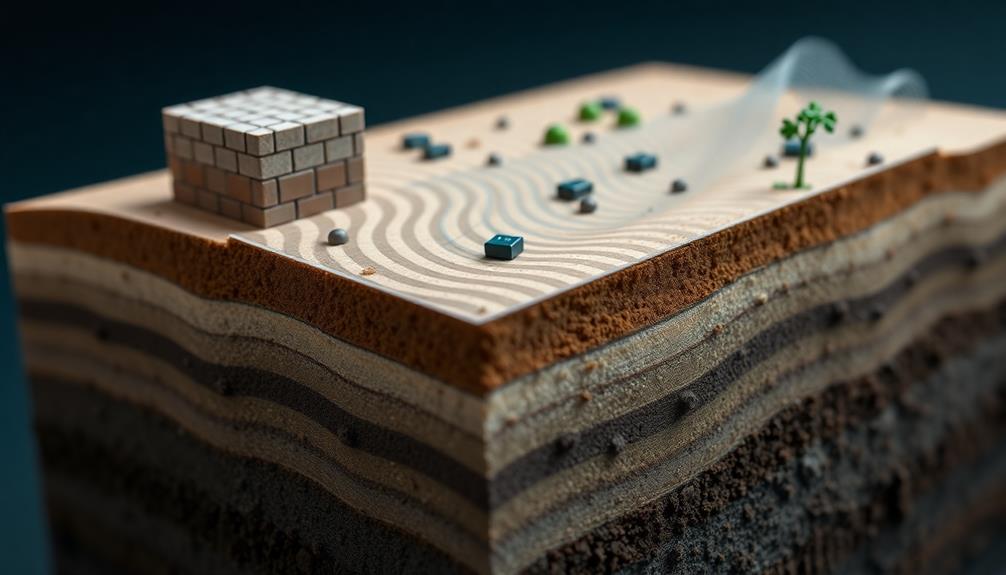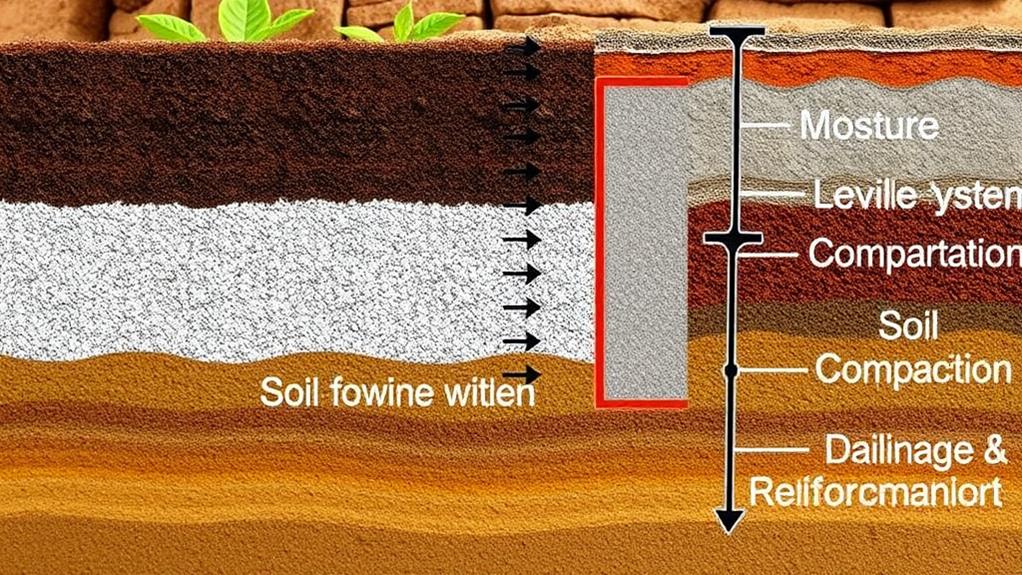Soil mechanics are essential in retaining wall design as they provide vital insights into earth pressure distribution, soil-structure interaction, and overall stability. By analyzing active and passive soil states, determining lateral earth pressure coefficients, and applying theories like Rankine's, engineers can accurately predict forces acting on the wall. This knowledge enables the creation of structurally sound designs that withstand substantial loads, resist environmental stressors, and maintain long-term integrity. Proper application of soil mechanics principles leads to improved structural stability, enhanced load-bearing capacity, optimized material selection, and increased project longevity. Additionally, it allows for the incorporation of seismic considerations, ensuring wall stability even in earthquake-prone regions. Exploring these concepts further reveals the intricate relationship between soil behavior and retaining wall performance.
Table of Contents
ToggleWalls Contractor Highlights
- Soil mechanics assess active and passive earth states, determining lateral pressures crucial for wall stability and design.
- Lateral earth pressure coefficients derived from soil mechanics are essential for predicting forces acting on retaining walls.
- Rankine's Earth Pressure Theory, based on soil mechanics, provides a simplified method for analyzing soil pressure distribution.
- Proper understanding of soil mechanics enables optimized material selection, enhancing wall durability and reducing lifecycle costs.
- Soil mechanics principles are vital for seismic considerations, ensuring retaining wall stability during ground motions and potential liquefaction.
Soil Pressure Distribution Analysis

Soil pressure distribution analysis is a critical component of retaining wall design, involving the assessment of active and passive earth states and their associated lateral pressures. In the process of constructing custom retaining walls, it's essential to examine soil mechanics for stability and longevity, aligning with the company's commitment to providing high-quality and long-lasting solutions for Twin Cities homeowners.
Understanding the lateral earth pressure coefficients is crucial for accurately predicting the forces exerted on the wall structure under various conditions. Rankine's Earth Pressure Theory provides a fundamental framework for calculating these pressures, offering engineers a dependable method to determine the magnitude and distribution of soil loads acting on retaining walls.
Active vs. Passive States
Understanding soil pressure distribution is pivotal for effective retaining wall design. The concepts of active and passive states play a vital role in this analysis, determining the forces exerted on the structure.
In the active state, the soil mass behind the wall tends to move away from the retaining structure, exerting minimal pressure. This occurs when the wall yields slightly, allowing the soil to expand horizontally. Conversely, the passive state develops when the wall moves towards the soil mass, compressing it and generating significant resistance.
Engineers must carefully consider these states when designing retaining walls, as they directly impact the stability and longevity of the structure. The active state typically governs the design of conventional retaining walls, where the goal is to minimize lateral earth pressures. However, in scenarios where the wall must resist external forces, such as in anchored or braced excavations, the passive state becomes critical.
Lateral Earth Pressure Coefficients
Building upon the concepts of active and passive states, lateral earth pressure coefficients provide a quantitative means to analyze soil pressure distribution. These coefficients, denoted as K, are essential for engineers and geotechnicians to accurately calculate the forces exerted by soil on retaining structures.
The three primary coefficients—at-rest (Ko), active (Ka), and passive (Kp)—correspond to different soil states and play indispensable roles in determining the stability and design of retaining walls.
The at-rest coefficient represents the natural state of soil before any movement occurs, while the active and passive coefficients reflect the minimum and maximum lateral pressures, respectively. These values are influenced by various factors, including soil type, friction angle, and wall inclination.
By utilizing these coefficients in conjunction with soil properties and wall dimensions, professionals can determine the magnitude and distribution of lateral earth pressures acting on a retaining wall. This information is fundamental for ensuring the wall's structural integrity, preventing failure modes such as overturning, sliding, or bearing capacity issues.
Ultimately, a thorough understanding and application of lateral earth pressure coefficients enable engineers to design safe, efficient, and cost-effective retaining structures that withstand the test of time and environmental forces.
Rankine's Earth Pressure Theory
As a cornerstone of geotechnical engineering, Rankine's Earth Pressure Theory provides a simplified yet effective method for analyzing soil pressure distribution on retaining walls. This theory, developed by William Rankine in 1857, assumes that the soil mass behind the wall is in a state of plastic equilibrium, with failure occurring along a plane of maximum obliquity. Rankine's approach calculates the lateral earth pressures acting on a vertical wall, considering both active and passive conditions.
The theory's primary advantage lies in its straightforward application, requiring only the soil's friction angle and unit weight as input parameters. It assumes idealized conditions, including a frictionless wall-soil interface and a horizontal backfill surface. While these assumptions may not always reflect real-world scenarios, they offer a conservative estimate of earth pressures, ensuring a margin of safety in design.
Engineers employ Rankine's theory to determine the magnitude and distribution of lateral pressures, which are important for sizing retaining wall components and evaluating overall stability. By understanding and applying this fundamental concept, designers can create robust structures that effectively resist soil loads, safeguarding both infrastructure and public safety.
Benefits

The benefits of proper retaining wall design extend far beyond mere aesthetics, encompassing pivotal structural and economic advantages. Improved structural stability and enhanced load-bearing capacity guarantee the wall's ability to withstand soil pressure and additional loads, thereby reducing the risk of failure and associated safety hazards.
Additionally, creative wall designs and the use of materials such as boulders can boost curbside charm while serving both functional and visual purposes. Optimized material selection and increased project longevity contribute to cost-effectiveness over time, minimizing the need for frequent repairs or replacements while maintaining the wall's functionality and appearance.
Improved Structural Stability
Improved structural stability stands as one of the primary benefits of well-designed retaining walls. When soil mechanics principles are meticulously applied, these structures provide robust support against lateral earth pressures, effectively preventing soil erosion and potential landslides.
The integration of proper drainage systems, carefully calculated soil bearing capacities, and strategically placed reinforcements guarantees that retaining walls can withstand substantial loads over extended periods.
Enhanced Load-Bearing Capacity
Substantial enhancements in load-bearing capacity represent a significant benefit of well-designed retaining walls. When soil mechanics principles are meticulously applied, these structures can withstand immense lateral earth pressures and surcharge loads, effectively stabilizing slopes and supporting adjacent structures.
The integration of advanced materials and innovative construction techniques further amplifies this capacity, allowing retaining walls to bear substantial loads without compromising structural integrity.
Optimized Material Selection
Through careful consideration, optimized material selection offers numerous benefits for retaining wall design. By carefully evaluating and choosing appropriate materials, engineers can considerably enhance the wall's performance, longevity, and cost-effectiveness. The selection process involves analyzing factors such as soil composition, environmental conditions, and structural requirements to determine the most suitable materials for each specific project.
Utilizing advanced materials, such as high-strength concrete or engineered geosynthetics, can drastically improve the wall's load-bearing capacity and resistance to environmental stressors. These materials often exhibit superior durability and require less maintenance over time, resulting in reduced lifecycle costs for property owners and municipalities. Additionally, the incorporation of sustainable materials, like recycled aggregates or locally-sourced natural stone, can minimize environmental impact and contribute to LEED certification goals.
Furthermore, optimized material selection enables designers to create aesthetically pleasing retaining walls that seamlessly integrate with the surrounding landscape, fostering a sense of harmony and belonging within the community. By prioritizing material optimization, engineers can guarantee that retaining walls not only meet structural requirements but also provide long-term value and satisfaction for stakeholders.
Increased Project Longevity
Ensuring increased project longevity stands as a paramount benefit of effective retaining wall design. By incorporating sound soil mechanics principles, engineers can drastically extend the lifespan of these indispensable structures. Properly designed retaining walls resist the detrimental effects of soil pressure, water infiltration, and environmental stressors, thereby maintaining their structural integrity over extended periods. This longevity not only reduces the frequency of costly repairs and replacementslybut also enhances the overall safety and stability of the surrounding landscape.
The implementation of advanced drainage systems, appropriate material selection, and meticulous construction techniques all contribute to a retaining wall's durability. By precisely evaluating soil properties and anticipating potential changes in ground conditions, designers can create walls that adapt to dynamic environmental factors. This foresight minimizes the risk of premature failure and confirms that the retaining wall continues to perform its intended function effectively for decades. Furthermore, the increased longevity of well-designed retaining walls provides property owners and communities with a sense of security and permanence, fostering a lasting connection to the built environment and contributing to the overall aesthetic and functional value of the landscape.
Seismic Considerations for Stability

Seismic considerations play a pivotal role in ensuring the long-term stability and safety of retaining walls, particularly in regions prone to earthquakes. A thorough approach to retaining wall design in seismic zones must incorporate dynamic earth pressure analysis, which accounts for the additional lateral forces exerted during ground motions. Engineers must also conduct meticulous assessments of site-specific seismic hazards and implement appropriate reinforcement strategies to counteract potential lateral forces, thereby enhancing the wall's resilience against seismic events.
| Seismic Design Aspect | Key Considerations | Implementation Methods |
|---|---|---|
| Dynamic Earth Pressure | Soil-structure interaction | Mononobe-Okabe analysis |
| Site-Specific Hazards | Ground acceleration, liquefaction potential | Geotechnical investigations |
| Reinforcement Techniques | Lateral force resistance | Geogrid reinforcement, tie-backs |
Dynamic Earth Pressure Analysis
How does seismic activity affect retaining wall stability? Dynamic earth pressure analysis is a critical component in evaluating the performance of retaining structures during earthquakes. This analysis considers the additional lateral forces exerted on the wall due to ground motion, which can drastically impact its stability and integrity.
In seismically active regions, engineers must account for both static and dynamic earth pressures when designing retaining walls. The Mononobe-Okabe method, an extension of Coulomb's earth pressure theory, is commonly employed to calculate seismic earth pressures. This approach incorporates factors such as soil properties, wall geometry, and seismic coefficients to determine the magnitude and distribution of lateral forces during an earthquake event.
The analysis also considers the potential for soil liquefaction, which can lead to increased lateral pressures and reduced soil strength. Engineers must evaluate the possibility of temporary surpassing of the wall's structural capacity during strong ground motions. Incorporating adequate factors of safety and implementing appropriate drainage systems can help mitigate these risks. By conducting thorough dynamic earth pressure analyses, designers can confirm that retaining walls remain stable and functional, even in the face of seismic challenges.
Site-Specific Seismic Hazards
When designing retaining walls in seismically active regions, a thorough assessment of site-specific seismic hazards is essential for guaranteeing long-term stability and safety. Engineers must conduct broad geotechnical investigations to evaluate local soil conditions, fault lines, and potential ground motion amplification. These studies involve analyzing historical seismic data, performing site-response analyses, and considering the likelihood of liquefaction or lateral spreading.
The design process incorporates seismic loads into stability calculations, often utilizing pseudo-static methods or more advanced dynamic analyses. Factors such as peak ground acceleration, spectral response, and duration of shaking are carefully considered. Engineers must also account for the potential increase in lateral earth pressures during seismic events, which can markedly impact the wall's performance.
To enhance resilience, designers may implement features like flexible connections, energy-dissipating systems, or reinforced soil structures. Regular maintenance and monitoring protocols are established to ensure the wall's continued effectiveness throughout its lifespan. By meticulously addressing site-specific seismic hazards, engineers can create retaining wall designs that not only meet current safety standards but also provide long-term protection for surrounding infrastructure and communities in earthquake-prone areas.
Reinforcement Against Lateral Forces
Lateral force resistance forms the cornerstone of seismic design for retaining walls. In regions prone to seismic activity, engineers must carefully consider the dynamic loads that can be exerted on these structures during an earthquake. The primary objective is to guarantee the wall's stability and prevent catastrophic failure, which could result in substantial property damage and potential loss of life.
To achieve this, a multi-faceted approach to reinforcement is typically employed. One common method involves the use of geosynthetic reinforcement, such as geogrids or geotextiles, which are strategically placed within the backfill soil. These materials work in conjunction with the soil to create a composite mass that can better resist lateral forces.
Additionally, the incorporation of tie-back anchors or soil nails can provide supplementary support by transferring loads deeper into the stable ground behind the wall. The design may also include increased wall thickness, enhanced drainage systems to mitigate hydrostatic pressure, and the use of flexible connections between wall segments to accommodate seismic-induced movements. By implementing these reinforcement techniques, engineers can greatly enhance the resilience of retaining walls against the complex lateral forces generated during seismic events.
Walls Contractor FAQ
How Do Climate Conditions Affect Retaining Wall Design and Soil Mechanics?
Climate conditions profoundly impact retaining wall design and soil mechanics. Factors like precipitation, temperature fluctuations, and freeze-thaw cycles can affect soil stability, moisture content, and erosion rates. Designers must consider these variables to guarantee long-term structural integrity and safety.
What Role Does Vegetation Play in Retaining Wall Stability?
Vegetation plays an essential role in retaining wall stability. It enhances soil cohesion through root systems, reduces erosion, and manages water content. Properly selected plants can markedly improve the overall performance and longevity of retaining structures, benefiting our communities.
Are There Eco-Friendly Alternatives to Traditional Retaining Wall Materials?
Eco-friendly retaining wall alternatives include recycled materials, gabion structures, and living walls. These options not only provide stability but also promote sustainability, allowing us to create harmonious spaces that blend seamlessly with the natural environment we all cherish.
How Often Should Retaining Walls Be Inspected for Potential Soil-Related Issues?
Retaining walls should be inspected annually and after significant weather events. Regular checks guarantee early detection of soil-related issues, maintaining structural integrity. Our community's safety depends on proactive maintenance, so let's prioritize these inspections together.
Can Retaining Walls Be Retrofitted to Improve Soil Mechanics Performance?
Retaining walls can indeed be retrofitted to enhance soil mechanics performance. Common techniques include installing additional drainage systems, reinforcing the structure with anchors or tiebacks, and improving the backfill material. These upgrades can substantially extend the wall's lifespan and stability.







